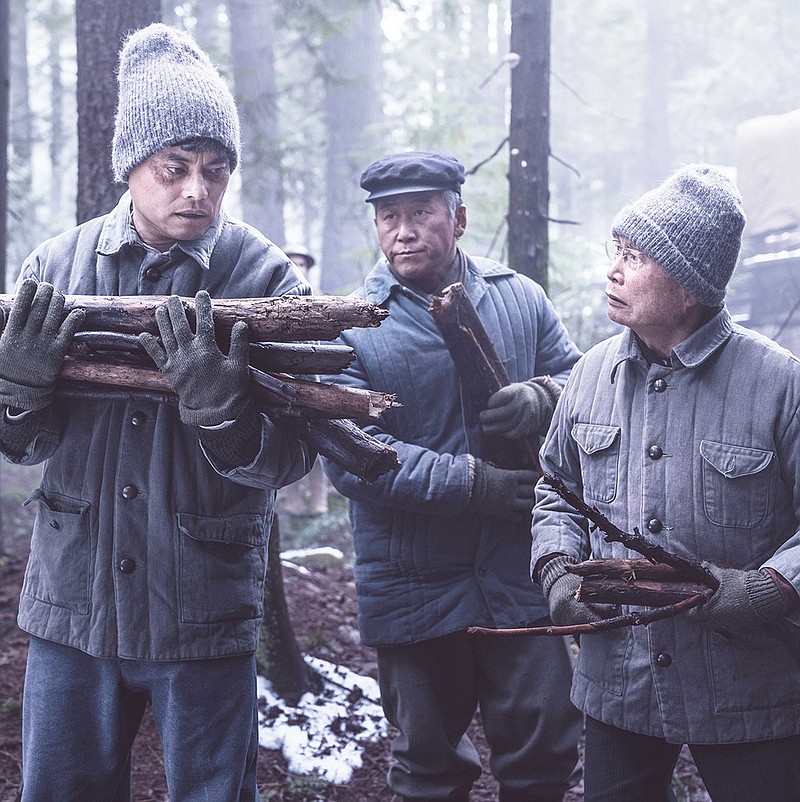BEVERLY HILLS, Calif. - Actor George Takei confronted scores of scary adventures as Lt. Sulu on "Star Trek," but they were nothing compared to what he really experienced.
Takei was a 5-year-old child when the United States declared war on Japan. And he and his parents were rounded up in the sweep that incarcerated many Japanese families.
"I was 5 years old when I was imprisoned and 8 and a half when I came out," he recalls. That proved a real horror story for Takei, and Monday he'll take part in a fictional one that often parallels his. AMC is premiering "The Terror: Infamy," a haunting story set against the backdrop of the Japanese relocations, complete with a paralyzing ghost spirit that invades the characters.
Takei, 82, was not only there on the set to perform, he also served as technical adviser. "When I saw the replica of the internment camp there built in Vancouver, British Columbia, I immediately recognized it, but I recognized it from the standpoint of a 5-year-old kid," he says.
"We had adopted a black, stray dog we called Blackie, and the place where he loved to crawl into when he had been reprimanded was that crawl space underneath the barrack. It was there, and I remembered it so well. The mess hall - the look and feel of it - the cacophony, the noise, and the crowding at the feeding trough. The look of everything was so authentic. It really took me back to my childhood."
Alexander Woo, co-creator and executive producer of the series, says Takei proved invaluable. "The first day we shot in that mess hall, he said, 'These dishes aren't chipped enough.' So we went and chipped a bunch of dishes so that we could have it completely authentic."
"They were wonderful, brand-new plates there, and what I remembered were chipped, cracked," says Takei. "Some of the plates leaked the juice of the slop that they put on it. And so we corrected that. And the cooks (on the set) were dressed in very neat, sanitary, white caps just like the restaurant workers. The way I remembered it was they - it got very sweaty in the kitchen and they had what we call 'hachimaki,' headbands, white cloth. And they were in undershirts. So we tried to tweak that a little bit so that I recognized it. But the extent of the details was really impressive."
All the speaking parts of the Japanese and Japanese-American characters are played by actors of Japanese descent. The series hero is portrayed by Derek Mio, a fourth generation Japanese-American whose grandfather lived on Terminal Island in California and was sent to an internment camp following the bombing of Pearl Harbor.
"When I first heard of the concept of this season, I just thought it was so brilliant because there's so many layers that are playing a hand," he says. "You have the terror that's a mysterious figure haunting this community. You have the terror of the government and its own citizens. You have different relationships breaking down.
"And the horror that you feel that these characters are going through is brought to life, and it's made more visceral. And so it just adds to that whole experience of this community. And so hopefully you can see that these are people just like anyone else. They might not look like your traditional television cast, but they're human. They have families. They have loved ones. And they'll do anything to protect them."
The season is masterfully directed by Josef Kubota Wladyka, whose grandfather survived the bombing at Hiroshima.
Discovery Documents Africa's Wildlife
The Discovery Channel is airing a new kind of documentary with its wildlife series "Serengeti." It's a natural history film shot in Africa combined with a storytelling narrative, says John Downer, the show's director-producer. "A documentary can only do so much because there are all these moments never to be missed," he says.
"And so, what we were able to do is to tell a very different story. I think if you look over the episodes as a whole, you get a feeling and an understanding of the place that you couldn't get through a normal documentary. All those lines of storylines intermesh and you see how these animals react with each other and how complex that world is, but also how connected it is."
During filming there were lots of surprises, says Downer. "One was when the leopard jumped out of the tree, probably a 20-foot drop onto the gazelle that then the hyena came in to try and steal. That had never been filmed and was something we were never expecting to film. It was a moment that just took all our breaths away when it happened.
"Then that developed into an even more amazing story where the hyena came in to tackle two leopards. Again, no one would believe any hyena would be brave enough to do that on her own, so that was pretty amazing. The other was a moment that was shot on a drone. We have an amazing drone pilot, and he was following a troop of baboons and they were going across the river He was following them and seeing where they're going. And then suddenly there was this commotion he could see in his screen and so he moved in the camera - and actually as it happened is how it appears in the film - he discovered that this python had got this female in its coils.
"All the baboons were trying to free the female, and then gave up because it was impossible - except for one, who clearly had that really close relationship with the female. And he just stayed and stayed and then tried one time to tackle and the snake lashed out . Well, no one's ever seen that, so how could we ever expect that to happen?"
Tribune News Service

